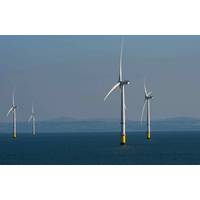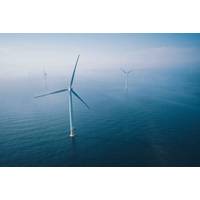Orsted and ESB won 900 MW of offshore wind tenders in Ireland
Orsted announced on Wednesday that Ireland had awarded the rights to build a 900 Megawatt (MW), offshore wind farm, to a joint-venture between Denmark's Orsted utility and Irish utility ESB. The Tonn Nua project was awarded with a 20-year contract-for-difference (CfD) secured at a strike price of 98.72 euros ($114.32) per megawatt hour. Developers are guaranteed a fixed electricity price. Any savings or costs resulting from wholesale price fluctuations will be passed on to consumers. In a separate announcement, the Irish energy ministry stated that the auction secured a "highly-competitive price in comparison to recent international auctions".
SBB sells community property portfolio worth $3.4 billion in a deal with Sweden
The struggling Swedish real estate group SBB announced on Tuesday that it would sell its portfolio of community properties to Public Property Invest, a publicly listed company in Oslo. This transaction valued the assets at approximately 32 billion Swedish crowns (3.40 billion dollars), and was part of its efforts to reduce its debt. SBB, which is a property firm that owns hospitals and care homes among other properties, has been forced to restructure its debt and reduce it due to high interest rates, and the economic downturn, especially in Sweden.
Orsted Has No Plans to Merge with Equinor's Renewables Unit

Danish offshore wind giant Orsted said on Wednesday that it had no plans to take over the renewables business of Equinor, its second biggest shareholder, which has proposed closer ties between the companies.Norwegian oil, gas and renewables group Equinor, which took a 10% stake in Orsted last year and injected close to $1 billion in an October share issue, said last week the offshore wind industry needed consolidation.Orsted's shares have plummeted 85% from their 2021 peak, hit by soaring costs and supply chain disruptions…
Colombia wins offshore wind bid by CIP of Denmark

The head of Colombia's hydrocarbons agency announced on Thursday that a subsidiary from Denmark's Copenhagen Infrastructure Partners, CIP, had bid to develop a wind project for the first round of the South American nation's offshore energy auction. Orlando Velandia of Colombia's National Hydrocarbons Agency, ANH, said that CIP subsidiary CI GMF Cooperatief U.A. ANH did not immediately provide details of the offer. ANH did not immediately disclose details of the offer. Velandia, who spoke at a Cartagena forum, said that the…
NATO will begin its annual nuclear drill Steadfast Noon on Monday.
Steadfast Noon will begin next week in the Netherlands, and 71 aircraft representing 14 countries will take part. Officials from the Western Military Alliance announced this on Friday. Rutte's remarks were recorded in a video at the Volkel airbase, Netherlands. This was the main host for this year’s drill. NATO has also announced that bases at Lakenheath, Britain, and Skrydstrup, Denmark, will be included. NATO officials confirmed that the exercise did not involve nuclear weapons, but rather simulated scenarios where they might be used.
Orsted will reduce its workforce by one-quarter by 2027
Orsted Denmark, the largest offshore wind farm developer in the world, announced on Thursday that it would cut 2,000 jobs, or a quarter, by the year 2027. Orsted explained that this was due to the fact that Orsted would be focusing on offshore wind in Europe and a number offshore wind farms are expected to be completed within the next few years. The company also needs to increase its competitiveness. The company has experienced rapid growth over the last decade, but recently it has faced a number of setbacks including disruptions to the global supply chain, rising interest rates and delays in projects that have impacted its share price. After its U.S.
South Africa coal heartland is home to a small solar city
Even though the locals are coughing up grey smog, coal keeps them at work, heats their homes during winter, and cooks dinner. Now, however, things are slowly beginning to change. South Africa, one of the largest coal exporters in the world, has launched a plan that will wean itself off coal pollution and embrace green industries to create jobs. Solar bricks - stackable lithium-ion batteries charged by sunlight - are used to power lights and mobile phones in almost every Nomzamo home. Nomzamo, despite only having 412 households in its program, sees it as the beginning of a major green shift for the country.
Bezos' renewables alliance targets $7.5 billion for developing countries
Executives from an alliance installing renewable energy in developing nations want to invest $7.5 billion over its next five-year plans. They are also looking for more philanthropic partnerships as richer countries cut their government aid. The Global Energy Alliance for People and Planet was launched in 2021 at the global climate talks. It has assisted more than 30 countries in improving electricity grids, setting up battery storage and creating jobs in green economy. The program secures money at a low or no cost from governmental…
Denmark buys $9 billion worth of air defence systems amid growing tensions with Russia
Denmark will buy air defence systems made in Europe for 58 billion Danish crowns (9.11 billion dollars), making it its largest ever arms purchase. The country's Defence Minister said this on Friday. He cited a difficult security situation. In February, the Danish Prime Minister Mette Fredericksen ordered that military equipment be purchased in anticipation of a possible future Russian invasion in Europe. Denmark is planning to purchase eight systems. These include the Eurosam SAMP/T long-range platform, which was developed by MBDA France and MBDA Italy, along with Thales. They also plan to buy medium-range systems from Norway, Germany, or France.
Draft shows that EU countries are trying to limit the ways in which Russian gas can be circumvented by EU countries.
A draft of the latest negotiation proposal for the rules seen by revealed that the European Union is trying to block any way Russian gas can still enter Europe after the phase-out. The European Commission proposed legislation in June to phase out EU oil and gas imports from Russia by January 1, 2028. This is because Brussels wants to end its decades-old relationship with Russia after its invasion of Ukraine in 2022. The EU is negotiating these plans and considering proposals that would make it more difficult for companies to "transit" Russian gas through Russia, after having been produced in another country.
Document shows EU wants proof of Russian gas origin in order to enforce Russian ban
A document obtained by revealed that European Union countries may impose stricter requirements for companies to prove the source of gas imported as part the bloc's plan phase out Russian imports. Last month, the European Commission proposed legislation that would phase out EU imports from Russia by January 1, 2028. This is part of a plan to end decades of energy relations between Russia and Brussels following Russia's 2022 invasion in Ukraine. It is notoriously hard to prove where the gas that may be mixed in transit originates.
New England officials claim that the US's decision to halt a wind project is a mystery.

Business and government leaders in New England claimed that the Trump administration's decision to stop work on a nearly finished wind farm near the coast of Rhode Island is a threat to grid reliability and jobs, and it defies any explanation. Connecticut and Rhode Island state leaders demanded information from the Trump administration on why the order was issued late Friday to stop work on the Revolution Wind project. The Bureau of Ocean Energy Management, in its letter to Orsted project developer, cited concerns about national security that were not specified. They say that there are national interests at stake.
Orsted Shares Drop as US Halts Offshore Rhode Island Wind Farm

Shares in Orsted plunged 17% on Monday after the U.S. halted the Danish company's Revolution Wind project off Rhode Island amid President Donald Trump's pushback on renewable energy investments.Orsted, the world's biggest offshore wind farm developer, has already faced mounting challenges, including rising costs, higher interest rates, and supply chain disruptions, leading to delays and cancellations in the U.S. and other markets. The company's market value has plummeted 87% since its January 2021 peak.The U.S. Bureau of Ocean Energy Management (BOEM) issued a work-stop order late on Friday for the $1.5 billion Revolution Wind project…
Nippon Steel to Supply Material for Vestas Wind Towers

Nippon Steel signed a cooperation memorandum with Denmark's wind turbine maker Vestas Wind Systems on Wednesday to supply steel for Vestas' wind towers for European, Asian and Japanese markets, Japan's industry ministry said.The agreement was part of a broader push by Japan's Ministry of Economy, Trade and Industry (METI) to strengthen the supply chain for wind generation in the country where renewables are key to reducing import costs and dependency on fossil fuels.Offshore wind is a pillar of Japan's renewable energy strategy…
Lindsey Oil Refinery, UK insolvency proceedings
The government's insolvency services announced on Monday that Britain's Lindsey refinery had begun insolvency procedures, raising the possibility of it closing weeks after Grangemouth stopped processing oil. According to the U.S. Energy Information Administration (EIA), Lindsey, one of Britain's six remaining oil refineries, is set to close, increasing Britain's dependence on fuel imports. According to its website, Prax has a capacity of 113,000 barrels a day. The government placed Prax Storage Lindsey and Prax Terminals Killingholme under judicial winding up orders.
Denmark warns EU not to stop green transition
The climate minister of Denmark said that European nations must not stop the green transition on the continent. His country is preparing to lead EU negotations over a new climate goal amid backlash from governments worried about its costs. Next week, the European Commission will propose a new climate target for 2040 that will reduce EU emissions by 90 percent compared to 1990 levels. However, countries such as Poland and France are concerned that this goal is too ambitious. Lars Aagaard is the energy and climate minister of Denmark.
Japan is poised to amend offshore wind regulations as players get coldfeet

Insiders in the industry say that Japan will likely sweeten its terms to developers who want to build an offshore wind farm. The country is looking to re-establish its energy ambitions against a global slump of projects that have been hit by rising costs and delays. By 2040, the government wants to reach 45 gigawatts in offshore wind power, which will reduce its dependence on coal and gas imports for electricity generation, as well as its carbon emissions, and strengthen national security. Its plans have stagnated after three rounds of major auctions for capacity development.
Japan is poised to amend offshore wind regulations as players get coldfeet

Insiders in the industry say that Japan will likely sweeten its terms to developers who want to build an offshore wind farm. The country is looking to re-establish its energy ambitions against a global slump of projects that have been hit by rising costs and delays. By 2040, the government wants to reach 45 gigawatts in offshore wind power, which will reduce its dependence on coal and gas imports for electricity generation, as well as its carbon emissions, and strengthen national security. Its plans have stagnated after three rounds of major auctions for capacity development.
Denmark Plans Offshore Wind Tender With Up to $8.3 Billion Subsidy

Denmark will launch offshore wind tenders with a capacity of three gigawatt (GW), enough to power three million homes, its energy ministry said on Monday, offering subsidies to developers of up to 55.2 billion Danish crowns ($8.32 billion).The three tenders will open in the autumn this year and cover two areas in the Danish North Sea and one in the waters separating Denmark from Sweden.Two tenders will close in spring 2026 and one in the autumn of 2027, with completion expected by 2032 and 2033 respectively.The offshore wind industry has grappled with skyrocketing costs, higher interest rates and supply chain bottlenecks, prompting governments to halt
Denmark Plans to Offer Up to $8.3 Billion in Subsidies for Offshore Wind

Denmark's energy ministry announced on Monday that it will offer offshore wind tenders for a maximum of 3 gigawatts (GW), which is enough to power up to three million homes. The subsidies offered to developers could reach as much as $55.2 billion Danish crowns (8.32 billion dollars). Three tenders are scheduled to open this autumn, covering two areas of the Danish North Sea as well as one area in the waters between Denmark and Sweden. The two tenders are expected to close in spring 2026, and the other in autumn 2027. Both will be completed by 2032 or 2033.